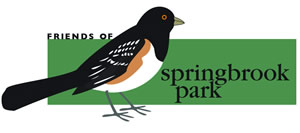Springbrook Park lies on the northern slope of Iron Mountain and is Lake Oswego’s oldest and largest natural area. Last logged in the 1950s, the recovering forest is a canopy of predominantly big-leaf maple and red alder, with some western red  cedar and Douglas fir. It is home to small wildlife and many birds, including the Spotted Towhee, which was part of a three-year Portland Audubon Society study with PSU graduate students .
cedar and Douglas fir. It is home to small wildlife and many birds, including the Spotted Towhee, which was part of a three-year Portland Audubon Society study with PSU graduate students .
The Park existed for 30 years without an assessment of its natural resources or a long-term plan to preserve, protect, maintain and enhance its valuable place in our community. Lake Oswego, like most cities in Oregon, is growing and experiencing increased density, which is prompting residents to more greatly value and protect remaining natural areas.
In 2003, a group of interested neighbors recognized this need and worked with the City of Lake Oswego to develop a Springbrook Park Management Plan that balanced two important goals for Springbrook Park: conservation and usage. The plan re-established Friends of Springbrook Park and directs it to provide ongoing support services that meet its mission to:
- Protect and preserve the park’s natural resources
- Enhance its user value
- Provide educational opportunities to schools and community
- Identify areas for protection
- Ensures use of the park is appropriate for its natural functions
The Management Plan will evolve over time based on assessments and inventories of current conditions and a description of the desired future conditions. It will delineate areas to protect, rehabilitate and restore, and describe appropriate use of the park and activities in it.
Ed Chinn

“The View from Springbrook Park” is available for free download. This book was written by long-time Uplands resident Ed Chinn. Ed created the book as a public service for Lake Oswego Schools and the Parks and Recreation Department. Ed never intended to sell his book.
The book is an illustrated history of our regional geology, Native Americans who lived here, Plant Ecology, and profiles of native plants and trees. There are hundreds of illustrations of our regional plants with detailed descriptions. Enjoy.
Thank you, Ed Chinn.
Ed Chinn is the author of The View from Springbrook Park, Lake Oswego, Oregon, An Illustrated Natural History. The book’s definitive geology, natural and Native American history, and plant ecology with beautifully illustrated native plants and trees makes it an invaluable reference. Copies of Ed’s book are at the Lake Oswego Public Library. In few words, Ed explains the past and future:
“Logging took place in Springbrook Park approximately 40 to 70 years ago. By examining the remaining tree stumps, we can determine that the original forest was dominated by medium to large stately conifers. Thus the forest of today, dominated by big leaf maple and red alder trees, took about 40 to 70 years to develop, and is very different from the forest that fell to loggers.”
Ed Chinn describes the current forest as predominantly hardwood (deciduous) trees with relatively short life spans of 60-85 years, characterized by vigorous growth that produces dense canopies and undergrowth of shade-tolerant plants and shrubs. It is estimated that approximately 80 years after logging, even without benefit of a reforestation program, the projected climatic conditions and low survival rate of hardwood seedlings would again result in the emergence of a conifer dominant forest. What the casual observer often sees as “forbidding scrub,” Ed envisions as being transformed by knowledge and action into an “enjoyable and peaceful glade.”
In the 70’s a dedicated group of Uplands neighbors successfully petitioned for not one, but two successful initiatives that helped create Springbrook Park and made it what it is today – a treasured nature area.
- In 1969, the City of Lake Oswego acquired a 28-acre site for park purposes.
- In 1973, Friends of Springbrook Park rescued an adjoining 24-acre parcel from the prospect of high-density housing development by petitioning for a special citywide election. Their efforts resulted in voter approval for acquisition of the property, which added to the existing city-purchased parcel, and enlarged the park to its present 52 acres.
- In 1978, an Oregonian article noted “A group that gained nationwide attention in 1973 when it stopped construction of a housing development is at it again.” Friends of Springbrook Park, again by initiative petition, sought to protect the park as a natural area. And again Lake Oswego voters agreed, mandating by a 3-to-1 margin, that the Lake Oswego City Charter be amended to designate and preserve Springbrook Park as a natural area.
Our History Since 2000
In the last decade, in response to growing concerns about the decline of red alder in the park, neighborhood association volunteers, students, church groups, and Boy Scouts planted over a thousand small Western Red Cedar and Douglas Fir seedlings.
April 2003 marked the first major trail development in Springbrook Park’s history. The City of Lake Oswego and the Uplands Neighborhood Association collaborated to design nearly two miles of trails that would better serve the needs of users and protect the natural resources of the park.
In the forty years since the park’s creation, the legacy of the founding group continues as new and old residents invest their time and labor in the protection, enhancement, preservation and maintenance of the park. In 2005 Friends of Springbrook Park partnered with the city to develop a Natural Resource Management Plan to meet long-term park needs. The Friends are responsible for implementing the plan and developing programs that meet its goals. The gift of your support will help continue the rehabilitation and educational projects in our urban natural area.